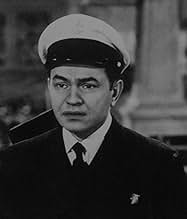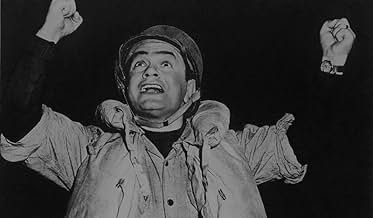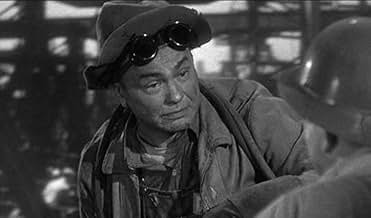Un nuovo cacciatorpediniere costruito per la Seconda Guerra Mondiale fallisce le prove in mare e viene assegnato alle spedizioni postali, ma finisce comunque per dover ingaggiare battaglia c... Leggi tuttoUn nuovo cacciatorpediniere costruito per la Seconda Guerra Mondiale fallisce le prove in mare e viene assegnato alle spedizioni postali, ma finisce comunque per dover ingaggiare battaglia con un sottomarino e aerei giapponesi.Un nuovo cacciatorpediniere costruito per la Seconda Guerra Mondiale fallisce le prove in mare e viene assegnato alle spedizioni postali, ma finisce comunque per dover ingaggiare battaglia con un sottomarino e aerei giapponesi.
- Regia
- Sceneggiatura
- Star
- Steve Boleslavski
- (as Edward G.Robinson)
- Casey
- (as Ed Brophy)
- Yeoman
- (non citato nei titoli originali)
- Moore
- (non citato nei titoli originali)
- Doctor
- (non citato nei titoli originali)
- 2nd Fireman
- (non citato nei titoli originali)
- Doctor
- (non citato nei titoli originali)
- Marine
- (non citato nei titoli originali)
- …
- Cook
- (non citato nei titoli originali)
- Sailor's Girl Friend
- (non citato nei titoli originali)
Recensioni in evidenza
The film begins with news of the USS John Paul Jones being sunk in the Pacific. That news is particularly hard for retired Navy chief Edward G. Robinson who now makes a living building ships in the navy yard. He gets to build the new John Paul Jones and decides that he ought to serve on her.
But when he pulls some strings to get assigned to the JPJ II, someone gets displaced as the chief boatswain. That someone is Glenn Ford and that doesn't make for a harmonious ship. In addition Robinson's kind of behind the times in the newer improvements the US Navy has made since the last war.
Complicating things is Marguerite Chapman, Robinson's daughter who Ford falls for. That really makes things bad on shore and off.
Robinson's the show in this film. His portrayal of an old Navy fighting man who won't be beached in a second war is sentimental, but effective. His best moments are when he finally begins to win the crew's respect by telling them the story of the guy and the engagement that the guy fought for whom the ship is named after.
In fact the final duel between the USS John Paul Jones and a Japanese submarine has a lot of similarity between what happened with the Bonhomme Richard and the Serapis of the Royal Navy.
Rounding out a nice supporting cast are Regis Toomey, Edward Brophy, Edgar Buchanan, and Leo Gorcey who gives us a bit of New York street smarts for the ship.
Destroyer is a dated propaganda film from the World War II era, but still entertaining because of the two leads.
When World War II broke out Wead was reactivated and helped with the planning and tactics involving naval aircraft in the Pacific. He went to sea and took part in several naval battles before finally retiring in early 1944. During the war and for several years after, he wrote the screenplays for a number of movies that Hollywood produced. Other big movies based on his books and screenplays include "Wings for Men" in 1931, "Test Pilot" in 1938, "The Citadel" in 1938, "Dive Bomber" in 1941, and "They Were Expendable" in 1945. Wead died at age 52 in 1947 after surgery. MGM produced a movie in 1957 about him, "The Wings of Eagles." John Wayne and Maureen O'Hara played Spig and his wife, Min.
Something about this movie, with the fact the Spig Wead wrote the story and screenplay, leads me to believe that there is a subtle message in it. The film came out toward the middle of the war, with two more years to go (although no one could know that at the time). And look at the plot. A new ship is taken out for trial runs and has so many things go wrong that it had to come back for repairs at least three times. We see rivets popping, seams leaking, pipes breaking, motors and other things blowing. As a viewer, I thought that the critics in the movie were right. The ship was a piece of junk – in spite of Edward G. Robinson's pleas to the contrary. And, just think – if that happened with all or many ships, it's a wonder we had a Navy afloat at all to do battle.
But that obviously wasn't the case – as the Navy brass ordered the ship to do mail delivery duty because it was unfit for service in the combat fleet. So, this ship just happened to be a lemon, right? Now think back to the opening scenes where Robinson is a civilian working on the crew that is building this new ship. Remember the several instances when he calls different workers to task for cutting corners? He tells one welder that he can't "cold" weld along a seam. The worker says that he can do that, and Robinson says that it would leak and he urges the guy to do it right. We see a few other subtle little scenes like this. I remember thinking that if that's the way the war-time shipbuilding yards were all working, they were sure doing a lot to help the enemy sink our ships.
But the volume of records and evidence we have show that our wartime industries and workers took pride in doing their jobs right and well. They knew that the planes, and ships, and tanks, and weapons they were making were for the Americans and other fighting men who were defending freedom and our shores with their lives. They were their sons and brothers, husbands and fathers, uncles and cousins, and boy friends and neighbors. So, the workers took pride in what they did and in doing it right.
That's why I think Wead wrote a subtle message into the screenplay – and Columbia kept it in the movie intentionally. It was a message to the home front workers about how important their jobs were and that they needed to do them well. The movie gave a picture of what could happen if the home front workers did sloppy work or cut corners. They would endanger the lives of many fellow Americans. They could cause the loss of ships, aircraft and battles.
If you doubt this, watch the movie again, and watch for those instances of shoddy or faulty workmanship that Robinson points out to his fellow workers. And then watch for the problems they have during their trial runs to get the ship battle ready. I'll just bet that the home front workers who saw this movie in 1943 were more than a little upset at what they saw. And if it had been up to them in real life, all those goldbrickers in the movie shipyard would have been canned.
Columbia was strictly 2nd tier as studios went in those days but this one is obviously an "A" as the studio went.
It has a great cast, special effects that rivaled the "big boys" and an ambiance that few could equal......
Watching the gleam in Eddie G's eyes really makes it fly..He singlehandedly steals the show......He has the right amount of humor and pathos to really make this film stand out. It's really a pity that no one knows this film in this day and age.....The use of old sea chanteys in the score brings a wonderful ambiance to the atmosphere..
This film also has two (in my opinion) classic lines in it. When Edgar Buchanan is dancing with a goldigger at the USO, she says "sailor, I understand you've gotten a pay raise, what will you do with it?" To which Buchanan replies: "Oh some on booze, some on women and the rest foolishly...". The other gem is where Robinson confronts Glenn Ford and makes the comment: "Why I've wrung more seawater out of my socks than you've sailed over!"
What can I say kiddies, this is one of my favorites and I consider myself fortunate to have it on VHS so I can watch it any time I want to.......It was released by "Hollywood Movie Greats" on VHS in 1990..... Robert
Lo sapevi?
- QuizThe USS John Paul Jones in reality was the Benson Class destoyer USS Hobby (DD610). She was primarily used for Anti-Submarine Warfare (ASW) in both the Mediterranean and Pacific theaters. She servived the war, but would eventually be destroyed as a training target in 1972.
- BlooperWhen the Japanese torpedo strikes the John Paul Jones II, the ship's interior is shown to have its interior watertight doors open. Part of General Quarters (Battle Stations) procedure is to establish watertight integrity throughout a ship by shutting all watertight doors. This minimizes flooding in the event the ship is struck by enemy fire.
- Citazioni
Girl at USO: I hear you got a raise.
Kansus Jackson: Yeah
Girl at USO: What are you going to spend it on?
Kansus Jackson: Oh, beer, women and the rest on foolishness.
- Curiosità sui creditiOpening credits prologue:
Destroyers --"Tin Cans" as they are affectionately called by those who man them -- are the busybodies of the Fleet.
Always looking for trouble -- generally finding it.
Proud little ships because they bear the names of great heroes of the Service and keep alive the fighting traditions of our Navy.
I più visti
- How long is Destroyer?Powered by Alexa
Dettagli
- Data di uscita
- Paese di origine
- Lingue
- Celebre anche come
- Algo más que la vida
- Luoghi delle riprese
- Azienda produttrice
- Vedi altri crediti dell’azienda su IMDbPro
- Tempo di esecuzione1 ora 39 minuti
- Colore
- Proporzioni
- 1.37 : 1
Contribuisci a questa pagina




































